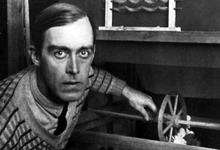- Images (2)
- Links (0)
- Agenda (5)

|

|

|

|
Son of a wealthy merchant, Walter Ruttmann studied architecture in Zurich from 1907, then painting in Munich in 1909, and later in Marburg. First successes as a painter. After the war, he returned to painting, especially abstract works. He began to take an interest in film theory, and in 1919 set up his own film production company near Munich. On his self-designed and later patented rig, he created LICHTSPIEL OPUS I (1919-21). This ten-minute experimental film, made up of over 10,000 separately colored images (often wave motifs), was the first "absolute" animated film in Germany. Three further abstract shorts were made up to 1925: LICHTSPIEL OPUS II, RUTTMANN OPUS III and RUTTMANN OPUS III, in which he refined his technique to become one of the leading exponents of avant-garde cinema in the 1920s. After making advertising films for Julius Pinschewer, Walter Ruttman directed the dream sequence in Fritz Lang's NIBELUNGEN (1922-24). For Lotte Reiniger, he created the animated backgrounds and special effects for the animated feature film (in cut-out paper silhouettes) "The Story of Prince Ahmed" (1923-26). Walter Ruttmann's masterpiece remains the experimental documentary film BERLIN, SYMPHONY OF A GREAT CITY (Die Sinfonie der Großstadt) (1926/27), a 65-minute film built on a musical structure, which presents a spring day in Berlin, from dawn to dusk. With his images of trains, machines, offices, cars, sports and nightlife, Ruttmann intends to create an artistic reality and intoxicate the viewer; he may convince some who consider "BERLIN" to be the major cinematic event of the era, while others deplore the fact that the film does not show the real life of Berliners, but remains superficial and formalist. Walter Ruttmann's second feature, THE WORLD'S MELODY (Melodie der Welt, 1928-29), a "symphonic documentary" for the Hamburg-America Line, was the first German-language feature. In 1932-33, Ruttmann shot ACCIAIO in Italy, a film about love and jealousy between two metalworkers; in 1934, he wrote a plot that was later not reused for Leni Riefenstahl's film about the Nazi party congress, The Triumph of the Will. He then worked as an advertising film director at Ufa, shooting cultural, advertising, industrial and other propaganda films. The industrial films METALL DES HIMMELS (Metall des Himmel, 1934-35) and MANNESMANN (Mannesmann, 1936-37) won awards in Venice, Brussels and Paris.

|
IN DER NACHT
1931 / 16mm / tinted b&w / sound / single screen / 7' 00 / 35 € distribution: 16mm or Digital file on server |

|
OPUS IV
1925 / color / silent / single screen / 4' 00 / 21 € distribution: DCP on server or Digital file on server |

|
OPUS II, III & IV
1923 / color / silent / single screen / 12' 00 / 54 € or 58 € distribution: 16mm or 35mm or DCP on server or Digital file on server |

|
OPUS III
1923 / color / silent / single screen / 4' 00 / 32 € distribution: DCP on server or Digital file on server |

|
LICHTSPIEL OPUS I
1921 / 35mm / color / sound / single screen / 9' 26 / 49 € distribution: Digital file on server |

|
OPUS II
1921 / 35mm / tinted b&w / silent / single screen / 3' 00 / 22 € distribution: DCP on server or Digital file on server |